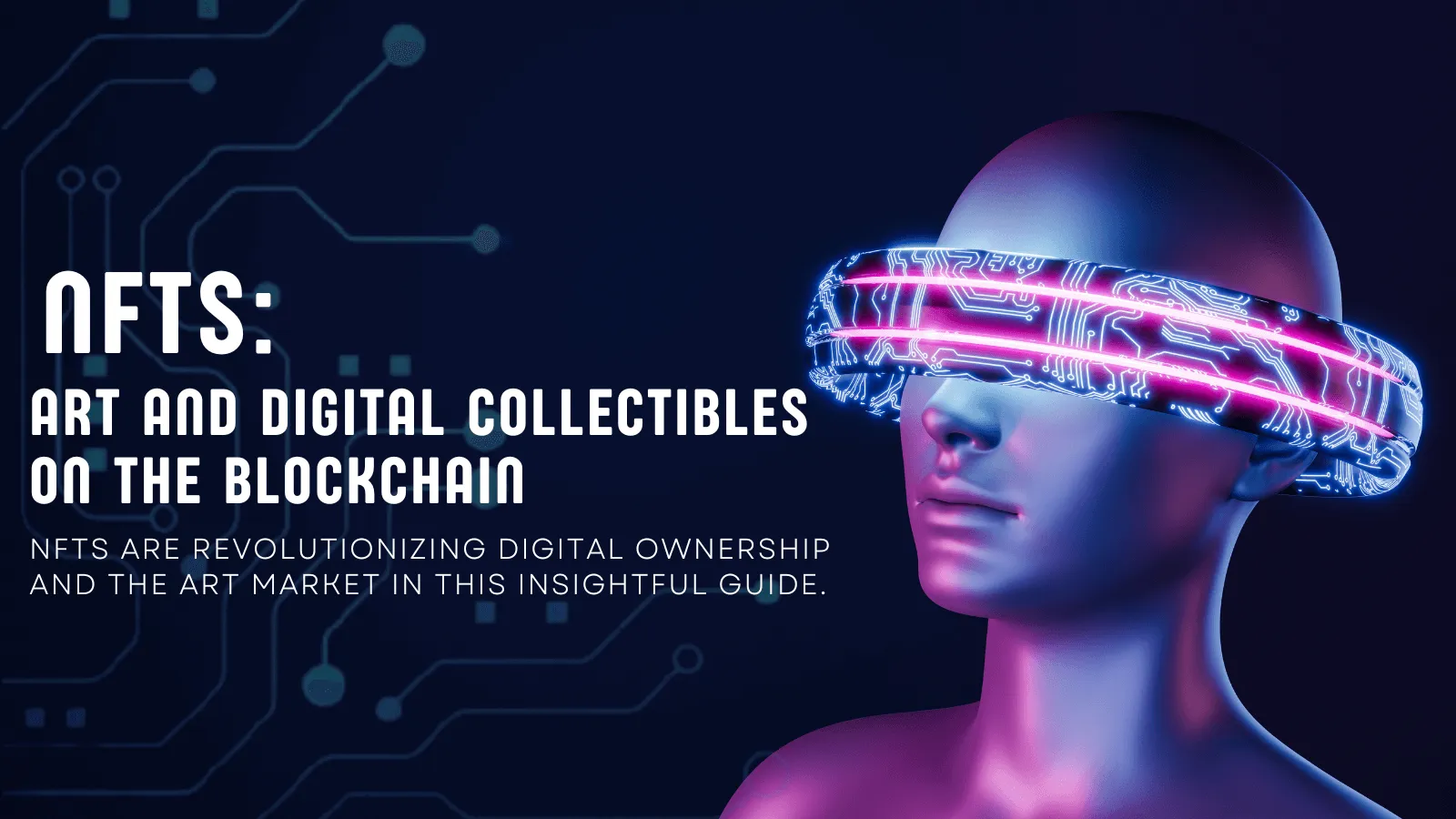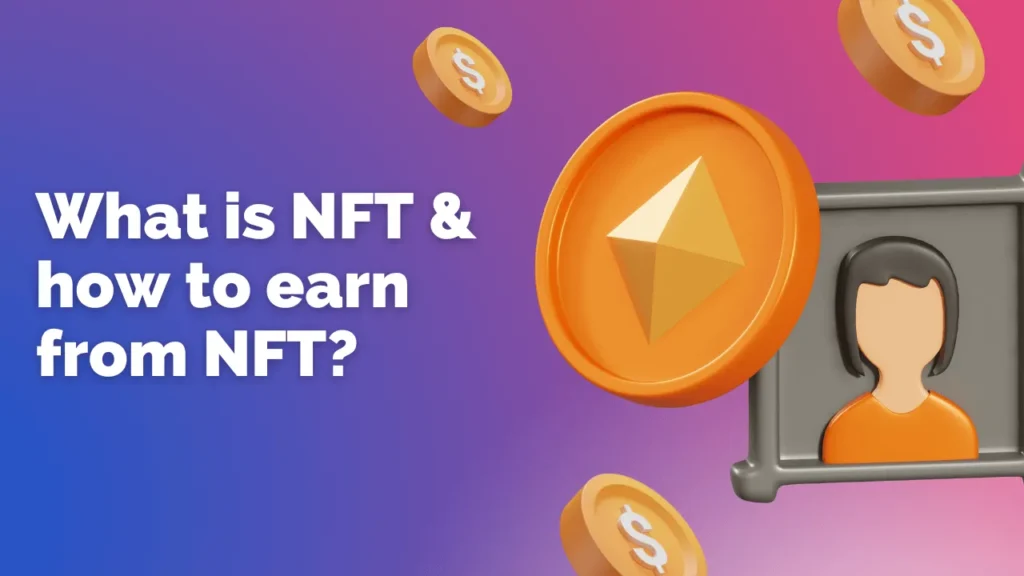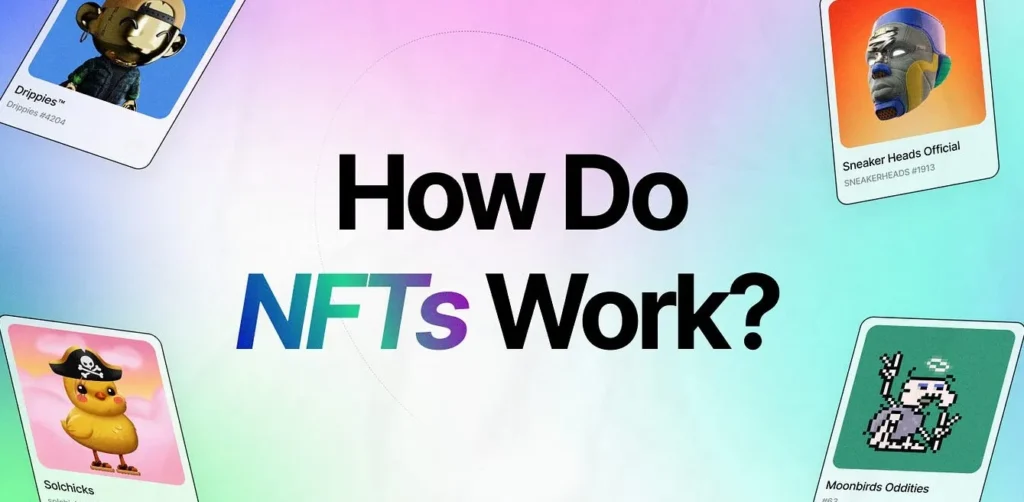
NFTs: Art and Digital Collectibles on the Blockchain
Cryptocurrency & and blockchain technology
- John Quarrie
- September 20, 2023
Introduction:
In the rapidly evolving landscape of the digital age, a groundbreaking technological innovation has emerged, fundamentally reshaping how we perceive and interact with art and collectables: Non-Fungible Tokens or NFTs. These cryptographic tokens, built on blockchain technology, have revolutionized how we authenticate, buy, sell, and own digital assets. NFTs represent a paradigm shift in art, offering artists new avenues for monetization and creative expression. At the same time, collectors gain unprecedented opportunities to own unique, verifiable pieces of digital history.
This blog post delves deep into the realm of NFTs, exploring their origins, their profound impact on art and digital collectables, and the ethical, legal, and environmental considerations surrounding their use. We’ll unravel the intricacies of how NFTs work, dissect prominent marketplaces, and glimpse into the future to uncover emerging trends and potential applications. Whether you’re an artist looking to tokenize your work, a collector curious about this new frontier, or intrigued by the NFT phenomenon, join us as we navigate the captivating world of NFTs and their role in shaping the digital landscape.
Investing in the Future: NFTs as Alternative Assets in Your Portfolio
1. What Are NFTs?
Non-Fungible Tokens, or NFTs, are revolutionary digital assets representing ownership and authenticity of unique items, typically on a blockchain. Unlike cryptocurrencies such as Bitcoin or Ethereum, NFTs are not interchangeable on a one-to-one basis due to their non-fungibility.
Each NFT is distinct, carrying a one-of-a-kind value and individual characteristics. NFTs have gained prominence in various domains, particularly in the art world, where they enable artists to tokenize their digital creations, providing a secure and verifiable proof of ownership. This technology extends beyond art into collectables, music, virtual real estate, and more, offering a new way for creators and collectors to interact with digital content. NFTs are often bought, sold, and traded on NFT marketplaces, fostering a thriving ecosystem where uniqueness and digital ownership take centre stage.

2. NFTs in Art:
NFTs have made an indelible mark on the art world, ushering in a digital renaissance transforming how we create, value, and collect art. Artists are leveraging NFTs to tokenize their digital works, granting them a new level of ownership and control over their creations. This innovation provides artists a direct channel to sell their work to a global audience, circumventing traditional gatekeepers. For collectors, NFTs offer a novel way to engage with art. They provide indisputable proof of authenticity and provenance, assuring buyers of the uniqueness of their digital acquisitions. NFTs also enable artists to receive royalties from secondary sales, creating a sustainable income stream.
However, this digital revolution has controversy. Critics argue that NFTs exacerbate environmental concerns due to the energy-intensive nature of blockchain transactions, and there are ongoing debates about copyright issues and the commodification of art. Nevertheless, NFTs have undeniably expanded the boundaries of art in the 21st century, sparking conversations about digital ownership, creativity, and the democratization of art markets.
3. Digital Collectibles and NFTs:
Digital collectables have found a new lease on life with the advent of Non-Fungible Tokens (NFTs). These tokens have revolutionized collecting by allowing individuals to own and trade unique digital assets securely and transparently. NFTs have made significant inroads into gaming, enabling players to own in-game items, characters, and skins as NFTs. This adds real-world value to virtual possessions and fosters player-driven economies within games. The concept of digital scarcity, made possible by NFTs, has created a sense of rarity and exclusivity in the digital realm, akin to physical collectables like baseball cards or stamps.
Moreover, NFTs have extended their influence beyond gaming to encompass various digital memorabilia, including virtual trading cards, digital art, virtual real estate, and even moments from live events. These items hold intrinsic value due to their uniqueness and blockchain-based provenance, making them sought-after items in the burgeoning digital collectables market.
4. How do NFTs Work?

a. Tokenization of Unique Assets
NFTs, or Non-Fungible Tokens, work by tokenizing unique digital or physical assets onto a blockchain. These assets range from digital art and collectables to virtual real estate, music, videos, and more. In contrast to fungible and replaceable cryptocurrencies like Bitcoin and Ethereum, NFTs stand for unique, one-of-a-kind assets.
b. Smart Contracts and Blockchain
NFTs are created and managed through smart contracts on blockchain platforms like Ethereum. Smart contracts are self-executing agreements with predefined rules that automate various aspects of NFT transactions, including creation, ownership, and transfer.
c. Unique Identifiers
Each NFT is assigned a unique identifier, often called a “token ID.” This identifier distinguishes one NFT from another and ensures its individuality. It is stored on the blockchain, making it immutable and transparent.
d. Proof of Ownership and Authenticity
Blockchain technology provides a transparent and tamper-proof ledger that proves the ownership and authenticity of an NFT. When you own an NFT, your ownership is recorded on the blockchain, and anyone can verify it. This eliminates the risk of counterfeit or fraudulent items in the digital world.
e. Transfer and Ownership Changes
When ownership of an NFT changes, the blockchain’s smart contract records the transaction, updating the ownership details and ensuring a transparent transaction history. Artists and creators may also include royalty mechanisms in their smart contracts, earning a percentage of the resale price whenever the NFT changes hands.
f. Interoperability and Standards
To ensure compatibility across different platforms and marketplaces, there are NFT standards like ERC-721 and ERC-1155 for Ethereum-based NFTs. These standards define the rules and structure of NFTs, making them easily transferable and universally recognizable. NFTs leverage blockchain technology and smart contracts to tokenize unique digital or physical assets, providing indisputable proof of ownership and authenticity. This technology has opened up new possibilities for creators, collectors, and enthusiasts in various fields, from art and gaming to entertainment.
5. NFT Marketplaces:
NFT marketplaces are online platforms facilitating the buying, selling, and trading of Non-Fungible Tokens (NFTs). These marketplaces serve as digital hubs where users can discover, purchase, and manage their NFT collections. Here’s an explanation of NFT marketplaces:
- Variety of Marketplaces: NFT marketplaces come in various forms, catering to different types of digital assets. Some marketplaces focus exclusively on digital art, while others offer various collectables, virtual real estate, music, and more.
- Blockchain Integration: Most NFT marketplaces are built on specific blockchains, with Ethereum being the most popular choice due to its robust smart contract capabilities. However, blockchains like Binance Smart Chain, Flow, and Tezos have also emerged as hosts for NFT transactions, each with its marketplaces.
- User-Friendly Interfaces: NFT marketplaces typically feature user-friendly interfaces, making it easy for newcomers and experienced users to browse, search, and interact with NFT listings. Users can view detailed information about NFTs, including descriptions, ownership history, and transaction history.
- Buying and Selling: Users can buy NFTs by placing bids on auctions or purchasing them at fixed prices. Sellers can list their NFTs for sale, set reserve prices, and specify auction durations. When a transaction occurs, the blockchain records the transfer of ownership, ensuring transparency and security.
- Wallet Integration: NFT marketplaces often require users to connect their cryptocurrency wallets, such as MetaMask or Trust Wallet, to facilitate transactions. This integration ensures that users have full control over their NFT collections and can manage them directly from their wallets.
- Secondary Sales and Royalties: Many NFT marketplaces support secondary sales, which means that creators may earn royalties (a percentage of the resale price) every time their NFT changes hands in the future. This royalty system benefits artists and creators long after the initial sale.
- Verification and Authentication: NFT marketplaces verify the authenticity of NFTs by checking the associated blockchain data. It helps prevent the sale of counterfeit or fraudulent NFTs and gives buyers confidence in the authenticity of their purchases.
- Community and Social Features: Some NFT marketplaces incorporate community and social features, allowing users to follow their favourite creators, join discussions, and participate in auctions or sales events.
- Curation and Discovery: NFT marketplaces often curate collections, spotlighting featured artists and trending NFTs. This curation helps users discover new and noteworthy digital assets.
6. Legal and Ethical Considerations:
Navigating the legal and ethical landscape of Non-Fungible Tokens (NFTs) presents a complex and evolving challenge. Copyright issues are at the forefront, with concerns over intellectual property rights and the potential for unauthorized use of copyrighted material in NFTs. Artists, collectors, and platforms must grapple with these legal complexities to ensure ethical practices within the NFT space. Additionally, environmental concerns have emerged due to the substantial energy consumption associated with blockchain networks supporting NFT transactions. This raises ethical questions about the environmental impact of NFTs and their sustainability.
Furthermore, the rise of NFT scams and fraudulent activities has prompted ethical considerations. Users must exercise caution to avoid falling victim to scams and unethical practices when buying or selling NFTs. Navigating these legal and ethical challenges is essential for the responsible growth and long-term viability of the NFT ecosystem, prompting discussions on regulation, intellectual property rights, and environmentally sustainable blockchain solutions.
7. Future of NFTs:
The future of Non-Fungible Tokens (NFTs) holds exciting possibilities across various domains. In art, NFTs will likely continue empowering artists, enabling direct engagement with global audiences, and reshaping the art market. Digital collectables, fueled by NFTs, will evolve with more immersive and interactive experiences in gaming and virtual environments. Moreover, NFT technology extends into real estate, education, and ticketing, transforming how we buy property, access educational credentials, and attend events. As blockchain scalability improves, NFTs may become more sustainable and efficient, addressing environmental concerns.
Interoperability among blockchain networks is promising, allowing NFTs to move seamlessly between platforms. Additionally, regulations are expected to mature, offering increased clarity and investor protection. Overall, the future of NFTs envisions a broader integration of digital ownership, creative expression, and innovation across industries while also addressing ethical, legal, and environmental considerations for a more sustainable and responsible NFT ecosystem.
Conclusion:
In conclusion, Non-Fungible Tokens (NFTs) have emerged as a transformative force, reshaping the digital landscape and redefining how we perceive ownership, art, and collectables. These unique cryptographic tokens have enabled artists to monetize their digital creations, collectors to secure verifiable ownership of digital assets, and innovators to explore uncharted territories in gaming, virtual real estate, and more. However, the world of NFTs has its challenges. Ethical, legal, and environmental concerns must be addressed as the ecosystem evolves. Nevertheless, NFTs have sparked a global conversation about digital ownership, creativity, and the democratization of markets, promising a future where the digital and physical realms converge in unprecedented ways. As we navigate this dynamic landscape, responsible engagement and ethical considerations will play a pivotal role in shaping the future of NFTs, ensuring their continued growth and relevance in our increasingly digital world.
FAQs:
1. What is an NFT?
An NFT, or Non-Fungible Token, is a unique digital token representing ownership and authenticity of a specific digital or physical item recorded on a blockchain.
2. How do NFTs work?
NFTs are created and managed through smart contracts on a blockchain. Each NFT has a unique identifier, and ownership is recorded transparently on the blockchain.
3. What can be turned into an NFT?
Anything digital or physical can be tokenized as an NFT, including digital art, music, videos, virtual real estate, collectables, and more.
4. How do I buy and sell NFTs?
You can buy and sell NFTs on NFT marketplaces using cryptocurrencies. Users connect their wallets to the marketplace, browse listings, and make transactions through smart contracts.
5. Are NFTs environmentally friendly?
The environmental impact of NFTs has raised concerns due to the energy-intensive nature of blockchain networks. Some blockchains are exploring more energy-efficient solutions.
6. Can I use copyrighted material in NFTs?
Using copyrighted material in NFTs without permission is legally problematic. Artists and creators should be mindful of copyright laws and obtain proper rights or licenses.
7. How do artists benefit from NFTs?
NFTs offer artists new revenue streams through direct sales and royalties on secondary market transactions, providing more control and income potential.
8. Are NFTs a good investment?
NFT investments can be volatile and speculative. It’s important to research and understand the market before investing and not solely rely on NFTs as an investment strategy.
9. What is the future of NFTs?
The future of NFTs includes:
- Continued growth in art and collectables.
- Expansion into various industries.
- Increased regulation.
- Ongoing discussions about sustainability and ethics.
10. How can I protect my NFT investments?
Protect your NFT investments by using secure wallets, verifying the authenticity of NFTs, and being cautious of scams and fraudulent offers in the NFT space.
Reference sites:
Here are some reference sites related to the topic “NFTs (Non-Fungible Tokens): Art and Digital Collectibles on the Blockchain”, where you can find in-depth information, news, and resources:
- CryptoSlate – NFT Section: Provides news, guides, and analysis of NFTs and their applications.
- NFT Wikipedia Page: A comprehensive Wikipedia page covering the basics of NFTs and their history.
- NFT.News: A news portal dedicated to NFTs, offering the latest updates and insights into the NFT space.
- OpenSea Blog: OpenSea is one of the largest NFT marketplaces. Their blog covers a wide range of NFT-related topics and trends.
- Nifty Gateway Blog: Nifty Gateway is another popular NFT marketplace with a blog featuring NFT news, artist spotlights, and more.
- Decrypt NFT Section: Decrypt covers cryptocurrency and blockchain news, including a dedicated section for NFT-related articles.
- NonFungible.com: Provides NFT market analysis, data, and statistics, including information on the most popular NFT collections.
- NFT Bible: A resource hub for NFT beginners, offering guides, tutorials, and FAQs.
- Foundation: An NFT platform that hosts artist profiles and interviews, providing insights into the NFT creation process.
- NFT Reddit: The NFT subreddit is a community-driven space for discussions, news, and insights related to NFTs.

